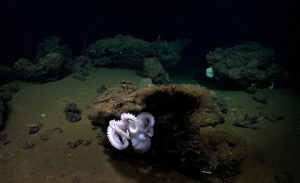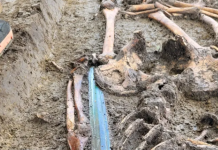About two miles below the surface of the Pacific Ocean, off the coast of Costa Rica, scientists have discovered an active octopus nursery. It might be the third known instance of a location where a large number of creatures have congregated to lay their eggs.
Scientists on board the Schmidt Ocean Institute’s Falkor research vessel spotted hundreds of octopuses during a recent three-week excursion. They were observed hatching their young on the Dorado Outcrop. The outcrop is around the size of a soccer field.
This area was one of six underwater mountains investigated by the ROV SuBastian, the ship’s underwater robot, which was submerged 2,800 meters (1.7 miles) deep into the lower depths of the so-called twilight zone. The mission also obtained footage of coral gardens, rays, tripod fish, and other deep-ocean creatures.
Beth Orcutt, a geomicrobiologist and senior research scientist at the Maine-based Bigelow Laboratory for Ocean Sciences, led the expedition along with Jorge Cortés, a researcher at the Center for Research in Marine Sciences and Limnology at the University of Costa Rica.
“We could see that some of them were ready to pop — like the octopus just came out,” she said. “It was a really exciting moment because we weren’t expecting it.”
A mystery was solved when in 2013 scientists found this active group of octopus parents and babies. Octopuses are normally solitary animals that prefer cooler waters.
This grouping of octopuses on a low-temperature hydrothermal vent, a hole in the seafloor where warm, chemical-rich fluids spill out, was the first time it had been observed.

Scientists counted 186 eggs and found that the octopuses appeared anxious and were unable to see any developing babies within them. The research team concluded that the environment was too hostile to be a good place to start a family.
“I was part of the team that went to the site (10 years ago). We just went to that one outcrop to look for evidence of low-temperature vents and discovered that there were those octopuses, but they didn’t seem to be successfully brooding,” said Orcutt.
“So the goal was to go back to Dorado and figure out what’s going on, and we discovered it is an active nursery. We saw babies being born.”
A second, smaller octopus nursery was also discovered by the researchers on an unnamed seamount with a low-temperature hydrothermal vent.
The findings provide more proof that some deep-sea octopus species may hunt for low-temperature hydrothermal vents to raise their eggs. Even though the lower oxygen would make it more difficult to breathe, the warmer fluids may benefit egg development.
Octopuses are renowned for being selfless moms; after depositing a clutch of eggs, they stop eating and start to deteriorate, usually passing away by the time the eggs hatch.
Octopus specialist Janet Voight, an associate curator of invertebrate zoology at Chicago’s Field Museum was part of the latest expedition. She was one of three authors of a 2018 paper analyzing the initial footage taken in 2013.
“We don’t know why they are attracted to this place. Perhaps they just stumble upon it, perhaps they seek it out, maybe for the warmth, maybe for the bare rock, maybe for some reason beyond our comprehension,” she posited.
Voight and her coauthors hypothesized that there may be an octopus population in a nearby, healthier habitat and that the octopuses shown in the photographs and videos were a surplus population that had unintentionally decided to settle in the wrong area.








